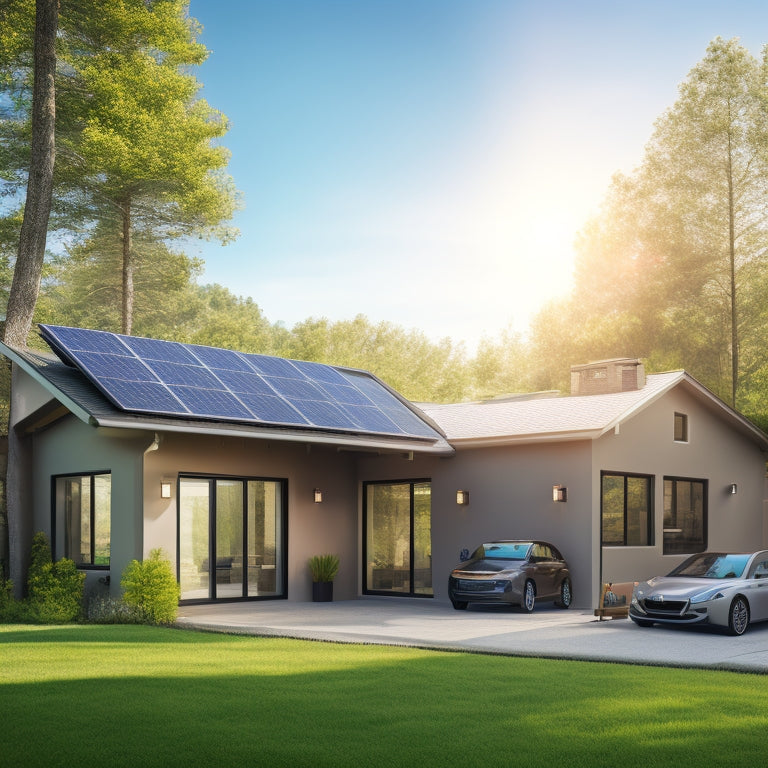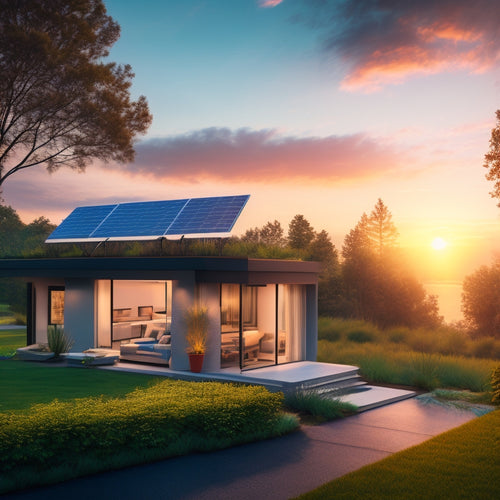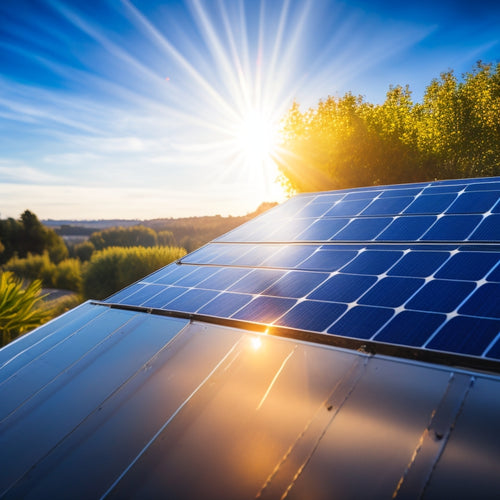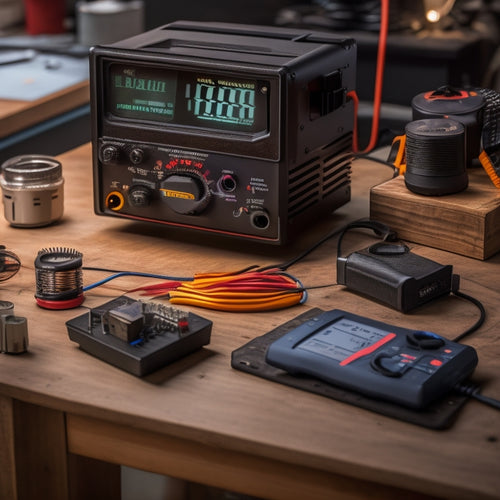
Powering Your Home With Battery Backup Systems
Share
By incorporating a battery backup system into your home, you can guarantee a reliable and consistent power supply, even when the primary source fails, and enjoy uninterrupted living with continuous operation of essential appliances like refrigerators and medical equipment. This integrated system contributes to energy independence, reduces reliance on fossil fuels during power outages, and allows you to stay connected without disruptions. As you investigate the benefits of battery backup systems, you'll uncover how to optimize energy efficiency, reduce environmental impact, and create a sustainable energy solution customized to your unique needs, opening a path to true energy independence.
Overview
- Battery backup systems provide reliable power during primary source failures, ensuring continuous operation of essential appliances.
- Solar energy storage is essential for consistent power supply, storing excess energy from solar panels for later use during night or outages.
- Choosing the right battery capacity is crucial, considering energy requirements, appliance consumption, and desired outage duration for optimal performance.
- Regular monitoring and maintenance of battery backup systems are necessary to prevent issues, ensure safety, and maximize energy savings potential.
- Integrating battery backup systems with renewable resources and smart technology can enhance grid independence, reduce energy bills, and minimize environmental impact.
Understanding Battery Backup Systems
Operating in the background of our daily lives, battery backup systems provide a reliable source of power when the primary source fails, ensuring continuous operation of vital systems and devices.
You rely on these systems to keep your home running smoothly, from refrigerators to medical equipment. By investing in advanced battery technology, you're taking a significant step towards energy independence, which is especially important in off-grid living and grid-tied situations.
With a battery backup system, you're no longer at the mercy of the grid, and you can rest assured that your essential appliances will continue to function even during power outages, reducing your reliance on fossil fuels.
This means you'll have the freedom to live life on your own terms, without interruptions or disruptions.
How Solar Power Works With Batteries
When you integrate solar power into your battery backup system, you're fundamentally utilizing solar energy to charge your batteries. This process, known as solar energy storage, allows you to store excess energy generated by your solar panels during the day for use during the night or during power outages.
As you'll see, the battery charging cycle plays a critical role in guaranteeing your system operates efficiently and effectively. By opting for systems that provide easy installation and maintenance, you can minimize costs and risks sustainable energy initiatives.
Additionally, purchasing online can reduce your carbon footprint, contributing to a more environmentally friendly approach.
Solar Energy Storage
As you investigate the world of solar energy, you'll soon realize that solar panels alone aren't enough to provide a reliable and consistent power supply. That's where solar energy storage comes in - an essential component of achieving energy independence.
By pairing solar technology with battery backup systems, you can store excess energy generated during the day for use during the night or during grid outages. This not only reduces your environmental impact but also provides cost effectiveness and system compatibility.
With the ability to integrate with the grid, you can optimize your energy usage and maximize your renewable resources. In addition, having a solar battery backup system ensures business continuity and reduces reliance on non-renewable energy, mitigating rising costs.
Additionally, advancements in battery lifespan have made solar energy storage a viable option for homeowners seeking freedom from reliance on traditional power sources.
Battery Charging Cycle
Your solar panel system generates electricity during the day, but you'll need a way to store that energy for later use. This is where the battery charging cycle comes in.
The charging cycle involves converting excess energy from your solar panels into chemical energy, which is then stored in your batteries. Regular monitoring of battery state of charge (SOC) and depth of discharge (DOD) battery monitoring and maintenance prevents overcharging and undercharging, guaranteeing maximum charging efficiency and prolongs battery lifespan.
The charging process is controlled by a sophisticated system that guarantees maximum charging efficiency and prolongs battery lifespan. When the batteries are fully charged, the system redirects excess energy to the grid or other loads.
During the night or on cloudy days, the stored energy is discharged to power your home. By optimizing the charging cycle, you can maximize your energy independence and reduce your reliance on the grid.
Benefits of Home Battery Storage
Several clear advantages come with integrating a home battery storage system into your existing setup.
You'll enjoy cost savings by storing excess energy generated by your solar panels or wind turbines, reducing your reliance on the grid and lowering your electricity bills. By reducing your energy consumption from the grid, you'll also minimize your environmental impact.
With a home battery storage system, you'll have energy independence, ensuring you have power when you need it, even during outages. Additionally, you'll benefit from advancements in technology, which have made these systems more efficient and reliable.
In emergency situations, your system will provide backup power, giving you peace of mind. As a long-term investment, home battery storage systems are ideal for residential applications.
Choosing the Right Battery Capacity
Determining the ideal battery capacity for your home storage system is essential to guarantee you reap the benefits of energy independence and cost savings.
You'll need to calculate your energy requirements based on your appliances' power consumption and the duration you want to be powered during an outage.
Consider the type of batteries you'll use, as different battery types have varying depth-of-discharge (DOD) rates. A higher DOD rate means more usable capacity, but may reduce the battery's lifespan.
For accurate capacity calculation, consider factors like your home's energy usage patterns, the efficiency of your inverter, and the desired backup time.
Installation and Maintenance Tips
As you prepare to install your battery backup system, it's crucial to evaluate the physical environment where the batteries will be housed, since temperature extremes, humidity, and physical damage can greatly impact their performance and lifespan.
Make certain the area is well-ventilated, dry, and protected from direct sunlight.
Take safety precautions by wearing protective gear and following the manufacturer's guidelines.
Consider hiring a professional to handle the installation, as it may reduce installation costs and guarantee a safe, efficient setup.
Regularly inspect your system to identify potential issues before they become major problems.
Keep the area clean, and perform routine maintenance tasks, such as checking battery water levels and inspecting connections, to make sure your system operates at its best.
Maximizing Energy Savings Potential
When configuring your battery backup system, you're likely looking to maximize energy savings potential while ensuring a reliable power supply.
To achieve this, you'll want to optimize energy efficiency through smart technology that manages your energy usage. By implementing load management strategies, you can reduce peak demand and lower your energy bills, resulting in significant cost reduction.
Additionally, integrating renewable resources into your system enables you to utilize clean energy and minimize your environmental impact.
Peak shaving capabilities also allow you to store excess energy generated during off-peak hours, further reducing your reliance on the grid and increasing your grid independence.
Frequently Asked Questions
Can I Use a Battery Backup System With a Non-Solar Electrical Grid?
You can install a battery backup system with a non-solar electrical grid, choosing from various battery types, like lead-acid or lithium-ion, but be prepared for higher installation costs, potentially offset by increased energy independence and reduced grid reliance.
How Long Does a Typical Battery Backup System Last?
You calculate the critical component's credibility by considering its battery lifespan, typically ranging from 5 to 15 years, and energy capacity, which determines how long it'll keep your lights on during an outage, usually 8-12 hours.
Are Battery Backup Systems Compatible With All Home Appliances?
You'll find that most battery backup systems are compatible with common home appliances, but you'll need to check the power ratings to guarantee compatibility, as some systems may not support high-power appliances like electric water heaters or HVAC systems.
Can I Install a Battery Backup System Myself?
You can attempt a DIY installation, but be aware that battery backup systems require specialized knowledge and adherence to safety considerations, such as electrical and fire hazards, to avoid compromising your system's performance and your well-being.
Do Battery Backup Systems Require Regular Software Updates?
You'll need to perform regular software maintenance to guarantee ideal battery performance, as outdated software can reduce efficiency and overall system reliability, so it's essential to stay on top of updates to get the most out of your battery backup system.
Ready to Buy
As you flip the switch, your home hums to life, powered by the quiet confidence of your battery backup system. Like a shield against the grid's unpredictability, your stored energy stands ready, bridging the gap between sunshine and darkness. With every watt, you're writing your own independence story, freed from the whims of utility companies. Your home, a lighthouse of resilience, shines brighter with each passing day.
Related Posts
-

The Future of Residential Energy Storage
The future of residential energy storage looks promising and cost-effective for you. With lithium-ion battery prices ...
-

How Efficient Are Thin Film Solar Cells
Thin film solar cells provide an innovative approach to energy generation, boasting efficiency rates generally betwee...
-

Key Features of a DC to AC Converter
A DC to AC converter features high efficiency and conversion rates, which reduce energy costs and improve performance...


